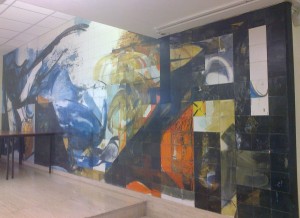Exhibitions by Peter Lanyon and Gertrude Hermes
Posted: January 15, 2016 Filed under: Uncategorized | Tags: Abstract art, art, artists, exhibitions, Gertrude Hermes, landscape, mural, murals, Painters, painting, Peter Lanyon, Pictures for Schools, prints, public art, sculpture 1 Comment Right at the beginning of my PhD, one of the books that excited me most on the list of reading I was given as a starting point was David Crouch’s Flirting with Space: Journeys and Creativity. The book contains a chapter by my second supervisor, Mark Toogood, on the Cornish abstract artist Peter Lanyon (1918-1964) and the ways he experienced and engaged with landscape.
Right at the beginning of my PhD, one of the books that excited me most on the list of reading I was given as a starting point was David Crouch’s Flirting with Space: Journeys and Creativity. The book contains a chapter by my second supervisor, Mark Toogood, on the Cornish abstract artist Peter Lanyon (1918-1964) and the ways he experienced and engaged with landscape.
I was, therefore, excited to discover that Lanyon had exhibited paintings several times at the Pictures for Schools exhibitions – although I’ve not seen any evidence that he actually sold anything to schools through the scheme, being one of the more abstract and unconventional artists involved.
After investigating Lanyon further, I went to see his large-scale 1960 mural ‘The Conflict of Man with the Tides and the Sands’ in Fry and Drew’s Civil Engineering building at the University of Liverpool. Textured, enamelled tiles depict the forces of waves, and a sense of life, power and movement is captured not just through the use of colour and form, but through the physicality of the tiles themselves and the acts of mark-making encapsulated within them. It is one of my favourite ever pieces of public art. I saw more of Lanyon’s work at Tate St Ives, both paintings and 3D constructions of landscapes, when I visited in June 2014, where he was represented alongside other artists who had lived in, worked in and visited the town.
I finished 2015 by going to see an exhibition of Lanyon’s paintings and constructions at the Courtauld Gallery in London. Based on his experiences of gliding over the Cornish coast, they push the notion of landscape towards ‘airscapes’, depicting not just visual scenes but tracking movements through them in rich, dark blues and greens and swirling brush marks, engrossing the viewer in their colours, textures and mood.
Shortly before Christmas I also went to an exhibition of prints, sculptures and book illustrations by Gertrude Hermes (1901-1983) at the Hepworth Gallery in Wakefield. Hermes did sell a lot of work at Pictures for Schools, as well as serving on selection committees to choose artworks, and had a long-term involvement with the scheme. I was keen to find out more about her life and work.
Much of the work in the exhibition took the form of small and very intricate engravings and wood cuts, drawing on Biblical, mythical and natural imagery, and themes of fertility, repetition and reproduction. I found much of it very strange, heavy and unsettling and preferred her less allusive and referential work. Among my favourites were the cascading angles of ‘The Waterfall’; 1924 engraving ‘The Swimmers’, where the supple organic forms of swimmers intermingle with swirls of water; and ‘Through the Wind-Screen’, a 1929 wood engraving which ably uses shading to capture the mood of night-time driving along tree-lined country roads, where branches reach out to create something resembling dense tunnels and the beams of the headlights illuminate each section of the road ahead.
Like much of the work which was popular at Pictures for Schools, the work Hermes sold to schools often depicts animals, including the wintry 1955 linocut ‘Owls’, with its sparse, icy-looking trees; the 1965 linocut ‘Starlings’, which creates delicate pattern from natural forms and activity; and her 1958 linocut ‘The Ram’. Other work sold at Pictures for Schools shows places, such as Stonehenge. In differing versions of Stonehenge shown at the Hepworth, Hermes shows a talent for animating this set of rocks and their surroundings, not just through bringing their surface to life with expressive mark-making, but by creating brooding skies that almost appear to move before the viewer’s eyes. I felt that the power of these works was in the way they surpassed the observer’s expectations. We might think we know Stonehenge, Hermes seems to be saying, as something very English, ancient and static, but in fact it is constantly changing according to not just the light, the weather and the environment around it, but the experiences and perspectives the viewer brings to it and the way in which it is seen when it is really looked at.
I particularly enjoyed those works that incorporate vivid colour, such as her larger-scale linocuts, especially the blues and purples of ‘Ring Net Fishers (1955), in which the small, anonymous figures of the eponymous fishers are rendered almost unnoticeable in comparison with the intricacies of a large net cast over the crests of a tumultuous sea.
I also found Hermes’ sculpture, for which she was less well-known, to be of great interest, particularly that which incorporated elements of the found or makeshift – including sculptures atop bowling balls, or carved from pub skittles. Her design commissions also intrigued me, from a carved lectern for a school to car mascots to a range of doorknockers – particularly one which stylistically incorporated a frog.
